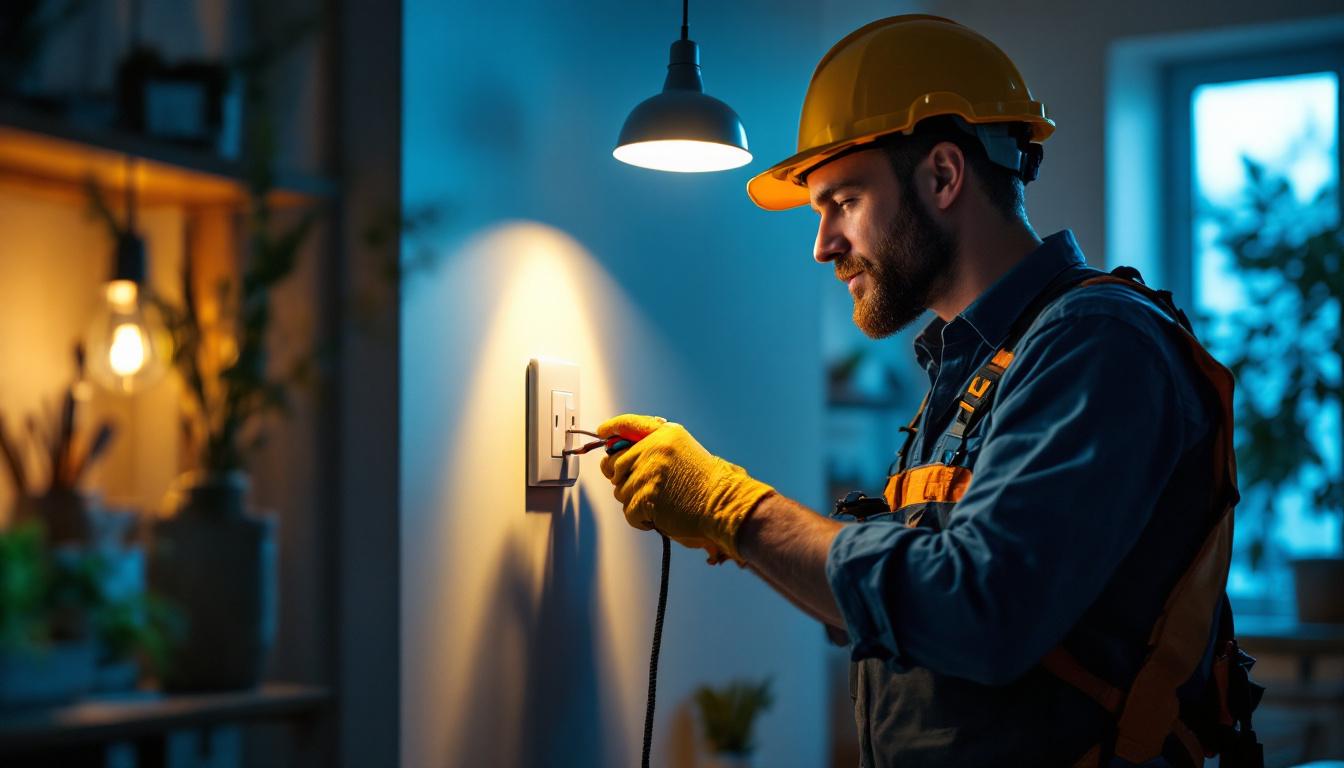
In the world of exterior design, outdoor lighting plays a pivotal role in enhancing aesthetics, safety, and functionality. For lighting contractors, understanding how to effectively train a team in patio lighting is essential for delivering exceptional results. This article delves into the strategies and techniques that can help contractors elevate their team’s skills in this specialized area.
Before diving into training methods, it’s crucial to grasp why exterior patio lighting is significant. Proper lighting not only beautifies outdoor spaces but also extends usability and improves safety.
Outdoor areas, particularly patios, are often the focal points of a home’s exterior. Thoughtfully designed lighting can highlight architectural features, create ambiance, and set the mood for gatherings. By using different types of fixtures, such as sconces, string lights, and spotlights, contractors can transform an ordinary patio into an inviting oasis.
Moreover, the strategic placement of lights can draw attention to landscaping elements, such as trees, shrubs, or water features, further enhancing the overall aesthetic. Training your team to understand these design principles is vital for achieving client satisfaction. For instance, using warm-toned lights can create a cozy atmosphere, perfect for evening gatherings, while cooler tones may be more suitable for modern, minimalist designs. Incorporating dimmers can also allow homeowners to adjust the brightness according to the occasion, making the space versatile and adaptable.
Beyond aesthetics, safety is a primary concern for any outdoor space. Well-lit patios reduce the risk of accidents by illuminating pathways, steps, and other potential hazards. Additionally, effective lighting can deter intruders, providing an added layer of security for homeowners.
Ensuring that your team recognizes the importance of safety in lighting design will enable them to make informed decisions about fixture placement and brightness levels, ultimately leading to safer outdoor environments. Furthermore, integrating motion-sensor lights can enhance security by illuminating areas when movement is detected, giving homeowners peace of mind while they enjoy their outdoor spaces. Educating your team on the latest technologies in outdoor lighting can empower them to offer innovative solutions that meet modern safety standards.
Outdoor living spaces are meant to be enjoyed, and proper lighting allows homeowners to utilize their patios even after sunset. By training your team to create versatile lighting solutions, they can help clients maximize their outdoor experiences throughout the year.
Understanding how to design lighting that accommodates various activities—such as dining, entertaining, or relaxing—can significantly enhance the functionality of a patio. This knowledge is crucial for any contractor aiming to provide comprehensive outdoor lighting solutions. For example, installing adjustable fixtures can allow for targeted lighting during dinner parties while providing softer ambient lighting for casual get-togethers. Additionally, incorporating smart lighting systems can enable homeowners to control their outdoor lighting through mobile apps, making it easier to set the perfect mood for any occasion. By staying informed about the latest trends and technologies in outdoor lighting, your team can offer clients solutions that not only meet their needs but also elevate their outdoor living experience.
Training a team in exterior patio lighting involves several key components. Each element contributes to a well-rounded understanding of design, installation, and maintenance.
Design principles form the foundation of effective lighting solutions. Contractors should ensure their teams are well-versed in concepts such as layering light, color temperature, and fixture selection. Layering light involves combining ambient, task, and accent lighting to create a balanced and inviting atmosphere.
Color temperature, measured in Kelvin, affects the mood of an outdoor space. Warmer tones (below 3000K) create a cozy vibe, while cooler tones (above 4000K) can feel more clinical. Training your team to choose the right color temperature for different settings will enhance their design capabilities. Furthermore, understanding the psychological impact of lighting can empower your team to create spaces that not only look beautiful but also evoke specific emotions, making outdoor areas more inviting for gatherings or serene for relaxation.
Understanding the technical aspects of exterior lighting is equally important. This includes knowledge of electrical systems, fixture types, and energy efficiency. Your team should be familiar with low-voltage systems, LED technology, and solar options, as these are increasingly popular in outdoor lighting design.
Additionally, training should cover installation techniques, wiring, and troubleshooting common issues. A solid grasp of these technical elements ensures that your team can execute projects efficiently and effectively. It is also beneficial to incorporate hands-on training sessions where team members can practice installation in real-world scenarios, allowing them to gain confidence and proficiency in their skills. Familiarity with the latest tools and technologies, such as smart lighting systems that can be controlled via mobile apps, will also keep your team ahead of industry trends.
Effective communication with clients is vital for understanding their needs and preferences. Training should include techniques for active listening, asking insightful questions, and providing clear explanations of design choices.
Encouraging your team to engage with clients throughout the design and installation process fosters trust and satisfaction. A team that can articulate the benefits of various lighting solutions will be more successful in securing projects and building lasting client relationships. Role-playing scenarios can be an effective training method, allowing team members to practice their communication skills in a controlled environment. Additionally, providing resources on cultural differences in design preferences can help your team navigate diverse client backgrounds, ensuring that they can cater to a wide range of tastes and expectations.
While theoretical knowledge is essential, hands-on training techniques are equally important for reinforcing learning. Practical experience helps solidify concepts and builds confidence in your team’s abilities.
Organizing workshops and live demonstrations can be an effective way to teach your team about exterior patio lighting. These sessions can cover a range of topics, from fixture installation to design principles.
Encouraging team members to participate in hands-on activities allows them to apply what they’ve learned in real-world scenarios. This experiential learning approach can significantly enhance retention and understanding.
On-site training offers a unique opportunity for your team to learn in the field. By visiting completed projects or ongoing installations, team members can observe best practices and gain insights into the challenges of outdoor lighting.
Encouraging team members to ask questions and discuss their observations can lead to valuable learning experiences. This approach not only enhances skills but also fosters a collaborative team environment.
Establishing mentorship programs can provide ongoing support for team members as they develop their skills. Pairing less experienced staff with seasoned professionals allows for knowledge transfer and personalized guidance.
Mentorship can also create a culture of continuous learning within your organization. By encouraging team members to seek advice and share experiences, you foster an environment where everyone can grow and improve.
In today’s digital age, technology can play a significant role in enhancing training programs. Utilizing various tools and platforms can streamline the learning process and make it more engaging.
There is a wealth of online resources available for lighting contractors. From webinars to online courses, these materials can supplement your team’s training and provide access to the latest industry trends and techniques.
Encouraging team members to explore these resources allows them to take ownership of their learning and stay updated on advancements in exterior lighting technology.
Simulation software can be an invaluable tool for training in lighting design. These programs allow team members to visualize lighting effects in different outdoor scenarios, helping them understand how various fixtures and placements impact the overall design.
By incorporating simulation software into training, your team can experiment with different configurations and gain confidence in their design choices without the risks associated with real-world installations.
To ensure that training programs are successful, it’s essential to evaluate their effectiveness regularly. This assessment can help identify areas for improvement and ensure that your team is equipped with the necessary skills.
Implementing feedback mechanisms, such as surveys or one-on-one discussions, can provide valuable insights into the training process. Encourage team members to share their thoughts on what worked well and what could be improved.
By actively seeking feedback, you demonstrate a commitment to continuous improvement and show that you value your team’s input. This can lead to a more engaged and motivated workforce.
Conducting performance assessments can help gauge the effectiveness of training programs. By evaluating team members’ skills and knowledge before and after training sessions, you can measure progress and identify areas that may require additional focus.
These assessments can also serve as a basis for setting individual development goals, ensuring that each team member has a clear path for growth and improvement.
Training your team in exterior patio lighting is an investment that pays off in the long run. By understanding the importance of effective lighting, incorporating key training components, utilizing hands-on techniques, and leveraging technology, contractors can build a skilled and knowledgeable workforce.
As outdoor spaces continue to evolve, the demand for skilled lighting professionals will only grow. By prioritizing training and development, contractors can ensure their teams are well-equipped to meet the needs of clients and deliver exceptional results.
In conclusion, a well-trained team not only enhances the quality of work but also fosters client satisfaction and loyalty. By committing to ongoing education and skill development, lighting contractors can position themselves as leaders in the industry, ready to tackle the challenges and opportunities that lie ahead.
Ready to elevate your exterior patio lighting projects with the finest products on the market? At LumenWholesale, we provide contractors with exceptional, spec-grade lighting solutions at unbeatable wholesale prices. Say goodbye to local distributor markups and hello to a vast selection of industry-standard lighting that ensures performance and reliability. With the added convenience of free shipping on bulk orders, LumenWholesale is your go-to source for quality lighting that meets both your budget and project needs. Don’t compromise on quality or value—discover wholesale lighting at the best value today and light up your clients’ outdoor spaces with confidence.

Discover how corn light bulbs are revolutionizing the lighting industry by offering unparalleled energy efficiency and longevity.

Discover the essential strategies lighting contractors use with light plug covers to enhance safety and aesthetics.

Discover the transformative power of Uvo lights in this comprehensive guide.

Discover the insider secrets of lighting contractors with our comprehensive guide to track bar lighting.